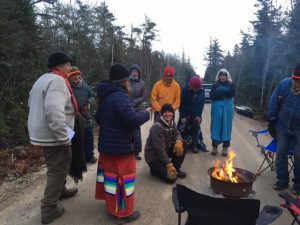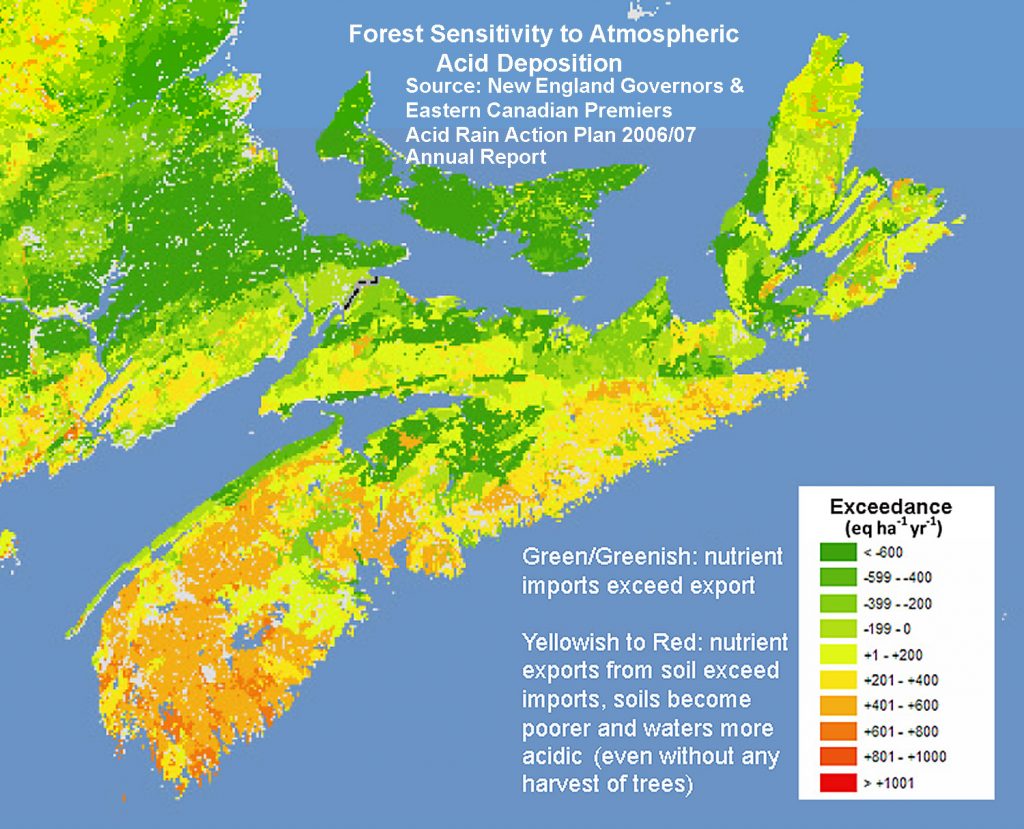Soils over more than 50% of the forested landscape in Nova Scotia simply need time to recover if we are ever to achieve truly sustainable harvesting, and to conserve and restore forest and aquatic biodiversity. At a minimum, we need to reduce the harvest on Crown lands to 500,000 cubic meters per year (from 820,576 cubic metres in 2019).

Sharing concerns about our natural world. Photo from 12 Days of Action, Day 11
UPDATE: Also View
– Comments by Karen Beazley (Feb 16, 2021)
Professor, Dalhousie School of Resource and Environmental Sciences
– Response to the draft: Nova Scotia Silvicultural Guidelines for the Ecological Matrix Lands by the Healthy Forest Coalition, Feb 15, 2021 comprehensive, 20 page document)
–Comments by Helga Guderley, Feb 17, 2021
– NatureNS response, Feb 18, 2021
– EAC Review of the Silvicultural Guide for the Ecological Matrix
Ecology Action Centre, Feb., 2021
– SGEM Response – Lindsay Lee (a fifth-generation woodlot owner and an avid hiker). Feb 2021
– and the previous three posts with submissions by Bev Wigney, Nina Newington, and Addie and Fred Campaigne
——-
I have written about these issues to Government many times going back to 2009 and on this website since 2016 and I was finding it difficult to drum up the enthusiasm to do it yet once again.
Events of past several months and the eloquent submissions on the SGEM shared recently on this website gave me the boost I needed, the sense that it is even more urgent to share our concerns about how we interact with the natural world that sustains us.
So here is what I sent to L&F today:
———————
Comments on the Revised SGEM
David Patriquin
Prof of Biology, Dalhousie University (retired)
Submitted to Nova Scotia Lands and Forestry, Feb 16, 2021
The guide is clearly a big improvement over the initially floated concepts/partial draft. (I attended the stakeholders meeting in Aug of 2019 as a rep of the Healthy Forest Coalition).
However the two major concerns I had with the initial version remain. # 1 is lack of reference to Landscape Level Planning for Biodiversity Conservation. In principle that comes from other projects notably the Old Forest Policy Project and the EA project about which we currently know next to nothing.
# 2. is nutrient management. The revised SGEM includes a procedure for assessing sustainability of nutrient supply as a factor in harvest planning. However the guide is vague in regard to what happens when the calculations show that a proposed harvest is not compatible with maintaining nutrient supply: “If HarMAI is greater than SusMAI for a given vegetation type (VT) and soil type (ST) combination, then harvest plan adjustments will be made.” What are the adjustments? These must be specified.
But more serious in my view is that the objective, as I understand it, is to maintain the current nutrient status. There is no provision to allow the nutrient status to improve on soils which are severely calcium depleted because of acid rain combined with the inherently poor soils that dominate on much of our landscape; previous harvesting has also contributed.
Atlantic salmon were the bellweather species for this phenomenon, identified by aquatic scientists studying the severe declines in salmon in Nova Scotia in the 1980s and 90s. The overall pattern of nutrient depletion in NS’s forest soils was clear over 14 years ago as shown by the map below:

Adapted from: Miller, E. et al. 2007. Mapping Forest Sensitivity to Atmospheric Acid
Deposition. Conference of New England Governors and Eastern Canadian Premiers Forest Mapping Group Report.
Those patterns have been confirmed and mapped in more detail in research by and contracted by L&F, initiated in 2009. Keys et al. (2016) provided the first public report on it. Application of the Forest Nutrient Budget Model in 2021 would mark 12 years after the research was initiated; in the interim no precautionary measures to limit impacts of forest harvesting on the most deficient sites have been applied.
Older forests that we still have on those soils today began growing and accumulating nutrients before the era of severe acid rain and hold nutrients that will not be available to the next generations if trees are harvested, so future yields and carbon sequestration will be lower during regrowth. Equally serious, severe calcium depletion affects many birds, fish and other wildlife, not just salmon*. Indeed, a case could be made that calcium depletion in our soils is the biggest threat to forest health and biodiversity in NS.
___________
*See for e.g., literature cited in a letter I wrote to government about this issue in 2014.
Remarkably, DNR/L&F has yet to highlight the significance of soil acidification/calcium declines for forest health and forest and aquatic biodiversity in educational and other materials distributed via their website, including the Field Guide to Forest Biodiversity Stewardship (2017) – and the Draft SGEM!
An “Inconvenient Truth” I have to believe is fully understood by at least some at L&F is this:
Soils over more than 50% of the forested landscape in Nova Scotia simply need time to recover if we are ever to achieve truly sustainable harvesting, and to conserve and restore forest and aquatic biodiversity. Even light harvesting will further contribute to nutrient depletion in many cases, particularly in southwest NS. Unfortunately, the time required for these soils to recover is greater than even the most far-sighted forest management planning period.
As difficult as it may be, we must acknowledge this issue and discuss it openly and honestly and begin to address it collectively. We owe that to future generations of all species that reside in Nova Scotia.
Other concerns
I am concerned about forging ahead with the revised SGEM when so many complementary projects and related decisions have yet to be and completed, notably the Old Forest Policy, the Natural Disturbance Regime, The Environmental Assessment, and High Production Forestry including the “strategic, long-term wood supply analysis”; and others not even, apparently, begun – re: Riparian Buffers (see Recommendation 25 in the Lahey Report) and with, still, no report on the Landscape Level Planning for Biodiversity exercise L&F has been conducting. From the Lahey Report, page 22:
Soon to be completed is a landscape planning pilot project to identify and develop options for linking prescriptions made at the stand level and broader landscape level forest management objectives, such as increasing the percentage of forest in old‐growth stands.25
25. The importance of this pilot project, and of the objective of being able to link stand‐level prescriptions to landscape‐level objectives, is recognized and emphasized both by the Review team (see Hunter and Wedeles, “Ecological Forestry,” in the Addendum) and by Nova Scotia’s Forest Biodiversity Science Advisory Committee (see Appendix F in the Addendum). Its importance (and urgency) is also implied by Hunter and Wedeles, “Ecological Considerations Related to Forestry,” in the Addendum.
Following the release of the Lahey Report in 2018, L&F moved quickly to remove some restrictions on WestFor that had been applied while the Review was in progress and at least in the public perception, gave Big Forestry pretty well everything it wanted and more. This was clearly contradictory to the spirit of the Lahey Recommendations.
“In other words, I have concluded that protecting ecosystems and biodiversity should not be balanced against other objectives and values as if they were of equal weight or importance to those other objectives or values. Instead, protecting and enhancing ecosystems should be the objective (the outcome) of how we balance environmental, social, and economic objectives and values in practising forestry in Nova Scotia.”
The essence of the Lahey recommendations was compromise (the Triad), yet that compromise to date has been applied only to the non-fibre values of our Crown land forests which have continued to be sacrificed to Big Forestry practices. This has generated even more public concern about logging practices and distrust of L&F than existed before the Lahey process was begun.
It is thus critical for the forests and their inhabitants and for the people of Nova Scotia to
(a) put an immediate moratorium on all existing clearcut-equivalent harvest approvals including Variable Retention 10-30%; Uniform Shelterwood; Overstory Removal and Salvage cuts;
(b) implement the draft SGEM;
(c) reduce the total volume of wood taken from Crown lands to a maximum of 500,000 cubic meters per year*;
(d) continue to review the SGEM, and issue the final version only when the complementary projects are also completed, all with appropriate public consultation and buy-in.
————–
*In my original post and submission I had cited 2 million cubic meters as the figure, but I had in mind the total for the province, not the Crown lands. “The total reported provincial harvest for 2019 was 3,314,626 cubic metres of solid wood”, the total Crown harvest was 820,576 cubic metres or 24.% of the total Provincial Harvest (Registry of Buyers 2020). So a reduction to 500,000 cubic metres would be a reduction of 39.1% on Crown lands, and 15% for the province as a whole.
A comment on the comment from Fred Schueler (Feb 17, 2021):
It’s important to emphasise that nutrient loss comes from two causes: 1) the removal of the bodies of trees, as trunks of conventional lumber, and of branches and tops which may be taken as “whole tree harvest” for pellets, and 2) leaching from the soil with reduced rootwebs from both trees and the various undergrowth, including spring ephemeral wildflowers — and that all the increase in nutrients comes from filtering out NPK from precipitation, which requires an intact rootweb, and that [for sustainability of nutrient supply ] logging cannot remove nutrients faster then the nutrients are accumulated from precipitation.
A good reminder, Thanks, FS! I think the Forest Nutrient Budget Model does not take into account accelerated leaching following clearcuts especially. In NS we have the additional challenge of making up for a period of accelerated leaching of nutrients induced by acid-rain (and possibly still continuing in SW Nova Scotia); that’s what makes it such a long term issue to return to the historic levels that existed when the present generation of old trees got established. If we don’t allow these depleted soils to recover, logging will push the forest more towards borealization as softwoods have lower nutrient requirements than hardwoods.
————–
Some related posts, pages
Biodiverse Southwest Nova Scotia at Risk
Post, October 29, 2018
CALCIUM DEPLETION
Page on this website
Why is the low base saturation/soil acidification/nutrient depletion/extreme surface water acidity in SW Nova Scotia still ignored in Crown land harvest decisions?
Post, November 20, 2019
More NSDNR research on Nova Scotia forest soils published in science journals but not publicized by NSDNR
Post, July 25, 2018
Lessons from New Hampshire: clearcutting on acidified soil reduces sugar maple regeneration, favours beech
Posted. April 1, 2018
What’s good for salmon is good for trees in Nova Scotia…and v. versa!
Post, December 13, 2016
Why we need a Precautionary Biodiversity Landscape Plan for Nova Scotia 16Mar2020
Post, March 16, 2020
Landscape-level “Log the best and leave the rest” on Nova Scotia’s Crown land forests 10Jan 2021
Post, January 10, 2021
